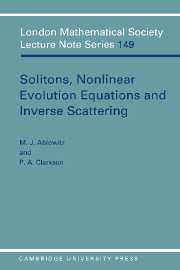Book contents
- Frontmatter
- Contents
- Preface
- 1 Introduction
- 2 Inverse Scattering for the Korteweg-de Vries Equation
- 3 General Inverse Scattering in One Dimension
- 4 Inverse Scattering for Integro-Differential Equations
- 5 Inverse Scattering in Two Dimensions
- 6 Inverse Scattering in Multidimensions
- 7 The Painlevé Equations
- 8 Further Remarks and Open Problems
- Appendix A Remarks on Riemann-Hilbert problems
- Appendix B Remarks on ∂ problems
- References
- Subject Index
8 - Further Remarks and Open Problems
Published online by Cambridge University Press: 04 February 2010
- Frontmatter
- Contents
- Preface
- 1 Introduction
- 2 Inverse Scattering for the Korteweg-de Vries Equation
- 3 General Inverse Scattering in One Dimension
- 4 Inverse Scattering for Integro-Differential Equations
- 5 Inverse Scattering in Two Dimensions
- 6 Inverse Scattering in Multidimensions
- 7 The Painlevé Equations
- 8 Further Remarks and Open Problems
- Appendix A Remarks on Riemann-Hilbert problems
- Appendix B Remarks on ∂ problems
- References
- Subject Index
Summary
In this book we have collated a considerable amount information regarding nonlinear equations solvable by an appropriate I.S.T. scheme and related methods on the infinite line and in infinite space. We have quite deliberately considered neither the periodic problem nor ad hoc techniques. Additionally we have included a very large pool of references.
In this final chapter, we briefly discuss some research problems, which, to our knowledge are currently open. There is a long list of open problems in ‘soliton theory’, both in the pure and applied aspects of the subject. Indeed, the fact that soliton theory has attracted the interest from a rather diverse group of scientists (e.g., both algebraic geometers and experimental physicists), demonstrates a deep and fundamental relationship with both modern and core Mathematics (e.g., algebraic and differential geometry, analysis, group theory and chaos) together with many physically significant applications (e.g., in plasma physics, fluids, optics and relativity). This is a reflection of the enormous diversity of the subject! The open problems we identify in this section are some of the more important ones, in our opinion, and ones which are currently attracting considerable interest.
The origins of soliton theory as we know it today were in the late 1960's with the pioneering work of Zabusky and Kruskal [1965] and Gardner, Greene, Kruskal and Miura [1967].
During the 1970's, inverse scattering techniques were developed for the solution of nonlinear evolution equations in 1 + 1-dimensions and some rigorous results were derived (e.g., for the Korteweg-de Vries (KdV) equation by Deift and Trubowitz [1979]).
Information
- Type
- Chapter
- Information
- Solitons, Nonlinear Evolution Equations and Inverse Scattering , pp. 424 - 439Publisher: Cambridge University PressPrint publication year: 1991
